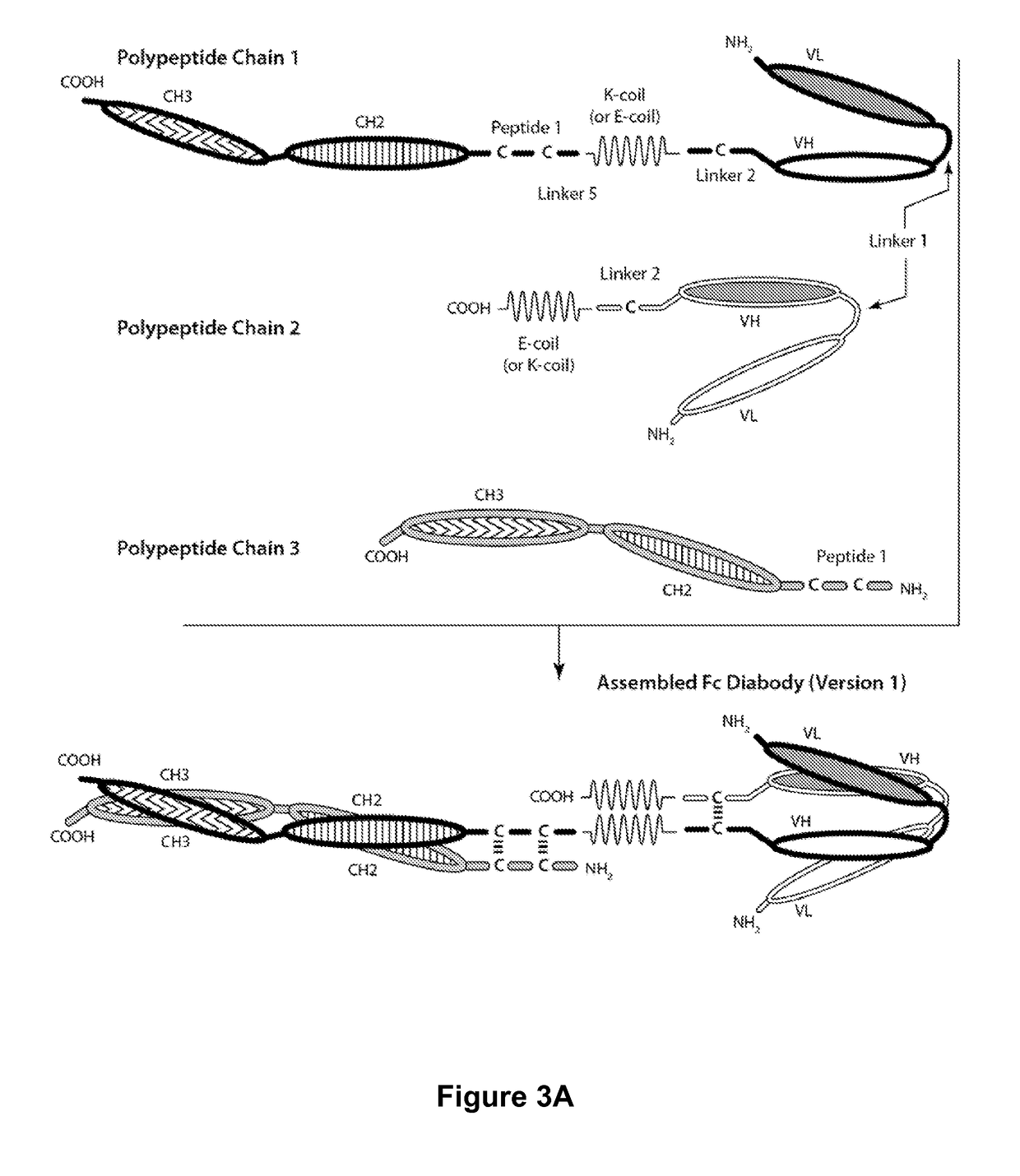Bi-specific monovalent diabodies that are capable of binding CD123 and CD3, and uses thereof
a monovalent diabolic and bi-specific technology, applied in the field of cd123cd3 bispecific monovalent diabolics, can solve the problems of hematopoietic failure, nausea and vomiting, and the death of most adults with aml from their diseas
- Summary
- Abstract
- Description
- Claims
- Application Information
AI Technical Summary
Benefits of technology
Problems solved by technology
Method used
Image
Examples
example 1
Construction Of CD123××CD3 Bi-Specific Diabodies And Control Protein
[0245]Table 2 contains a list of bi-specific diabodies that were expressed and purified. Sequence-optimized CD123××CD3 bi-specific diabody (DART-A) and non-sequence-optimized CD 123×CD3 bi-specific diabody (DART-B) are capable of simultaneously binding to CD123 and CD3. The control bi-specific diabody (Control DART) is capable of simultaneously binding to FITC and CD3. The bi-specific diabodies are heterodimers or heterotrimers of the recited amino acid sequences. Methods for forming bi-specific diabodies are provided in WO 2006 / 113665, WO 2008 / 157379, WO 2010 / 080538, WO 2012 / 018687, WO 2012 / 162068 and WO 2012 / 162067.
[0246]
TABLE 2PolypeptideNucleic AcidChain Amino EncodingBi-Specific DiabodiesAcid SequencesSequencesSequence-Optimized CD123 × CD3SEQ ID NO: 1SEQ ID NO: 2Bi-Specific Diabody (DART-A)SEQ ID NO: 3SEQ ID NO: 4(Binds to CD3 at epitope 1)Non-Sequence-Optimized CD123 ×SEQ ID NO: 5SEQ ID NO: 6CD3 Bi-Specific D...
example 2
Antibody Labeling Of Target Cells For Quantitative FACS (QFACS)
[0247]A total of 106 target cells were harvested from the culture, resuspended in 10% human AB serum in FACS buffer (PBS+1% BSA+0.1% NaAzide) and incubated for 5 min for blocking Fc receptors. Antibody labeling of microspheres with different antibody binding capacities (Quantum™ Simply Cellular® (QSC), Bangs Laboratories, Inc., Fishers, Ind.) and target cells were labeled with anti-CD123 PE antibody (BD Biosciences) according to the manufacturer's instructions. Briefly, one drop of each QSC microsphere was added to a 5 mL polypropylene tube and PE labeled-anti-CD123 antibody was added at 1 μg / mL concentration to both target cells and microspheres. Tubes were incubated in the dark for 30 minutes at 4° C. Cells and microspheres were washed by adding 2 mL FACS buffer and centrifuging at 2500×G for 5 minutes. One drop of the blank microsphere population was added after washing. Microspheres were analyzed first on the flow cy...
example 3
CTL Cytotoxicity Assay (LDH Release Assay)
[0250]Adherent target tumor cells were detached with 0.25% Trypsin-EDTA solution and collected by centrifugation at 1000 rpm for 5 min. Suspension target cell lines were harvested from the culture, washed with assay medium. The cell concentration and viability were measured by Trypan Blue exclusion using a Beckman Coulter Vi-Cell counter. The target cells were diluted to 4×105 cells / mL in the assay medium. 50 μL of the diluted cell suspension was added to a 96-well U-bottom cell culture treated plate (BD Falcon Cat#353077).
[0251]Three sets of controls to measure target maximal release (MR), antibody independent cellular cytotoxicity (AICC) and target cell spontaneous release (SR) were set up as follows:[0252]1) MR: 200 μL assay medium without CD123××CD3 bi-specific diabodies and 50 μL target cells; detergent added at the end of the experiment to determine the maximal LDH release.[0253]2) AICC: 50 μL assay medium without CD123××CD3 bi-specifi...
PUM
| Property | Measurement | Unit |
|---|---|---|
| length | aaaaa | aaaaa |
| concentrations | aaaaa | aaaaa |
| concentrations | aaaaa | aaaaa |
Abstract
Description
Claims
Application Information
 Login to View More
Login to View More - R&D
- Intellectual Property
- Life Sciences
- Materials
- Tech Scout
- Unparalleled Data Quality
- Higher Quality Content
- 60% Fewer Hallucinations
Browse by: Latest US Patents, China's latest patents, Technical Efficacy Thesaurus, Application Domain, Technology Topic, Popular Technical Reports.
© 2025 PatSnap. All rights reserved.Legal|Privacy policy|Modern Slavery Act Transparency Statement|Sitemap|About US| Contact US: help@patsnap.com



